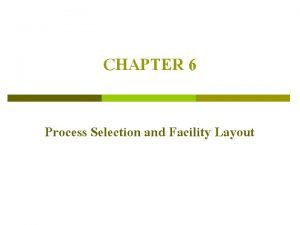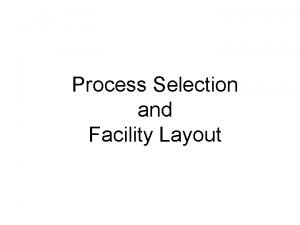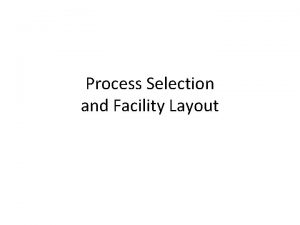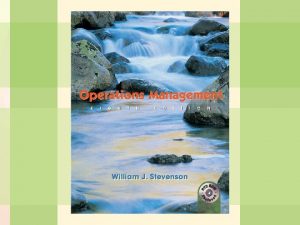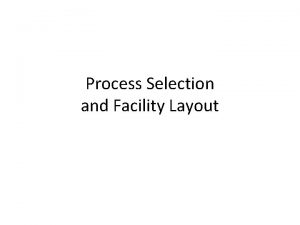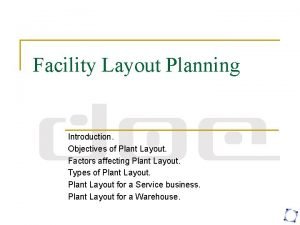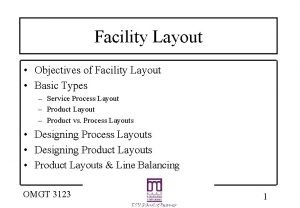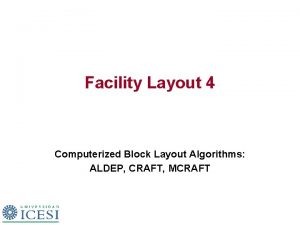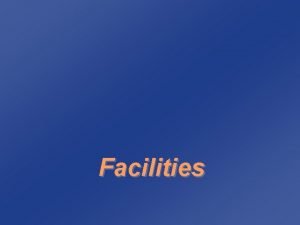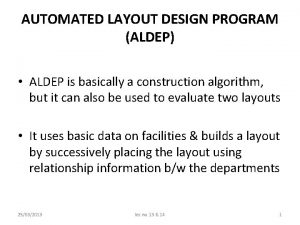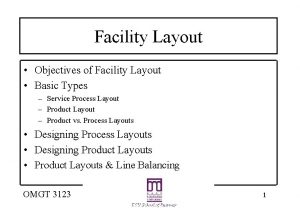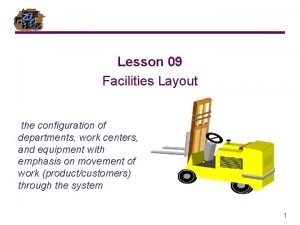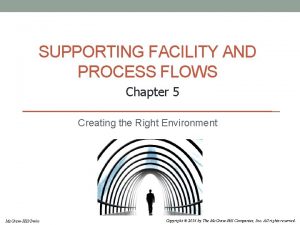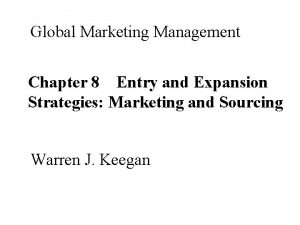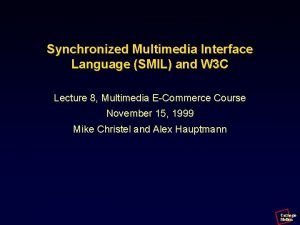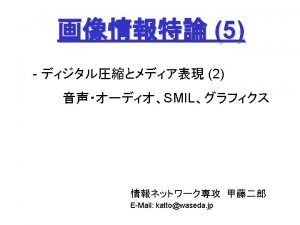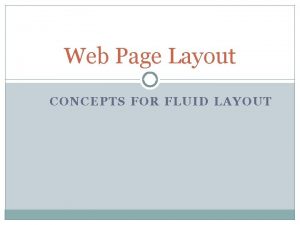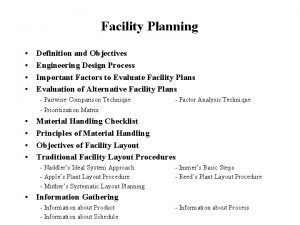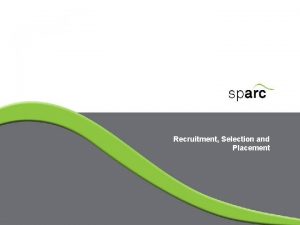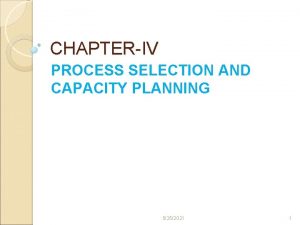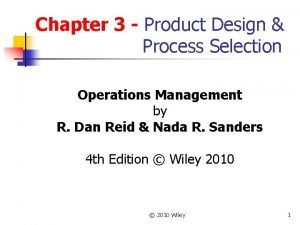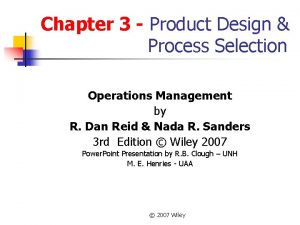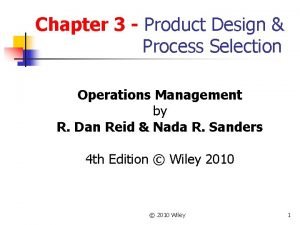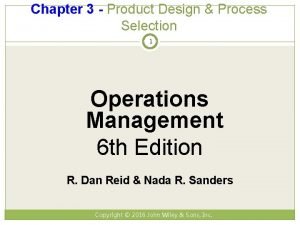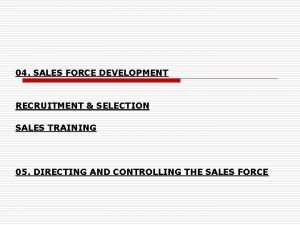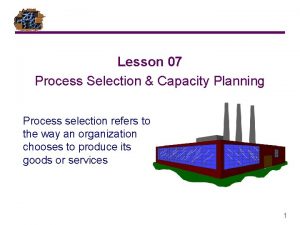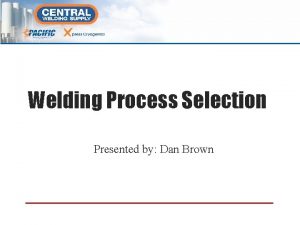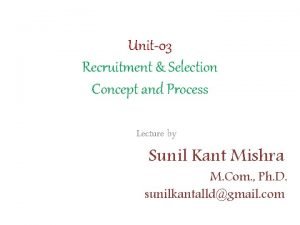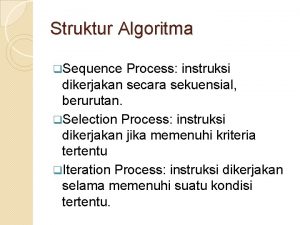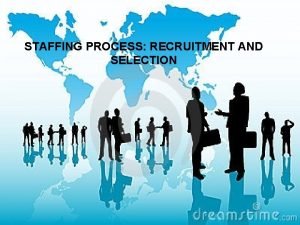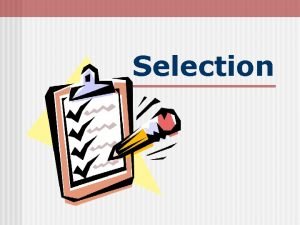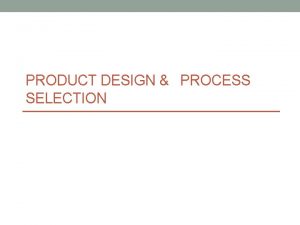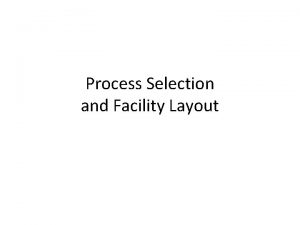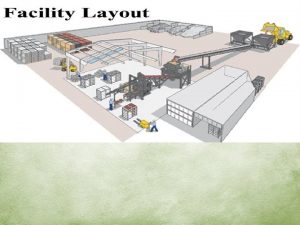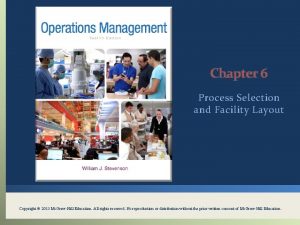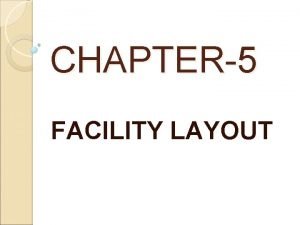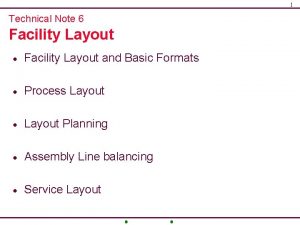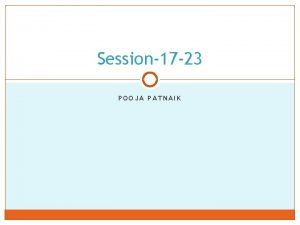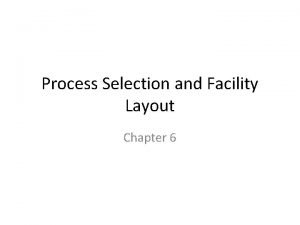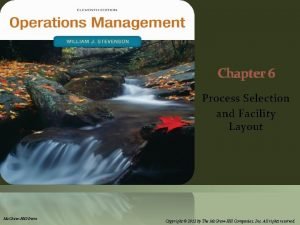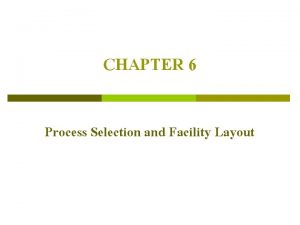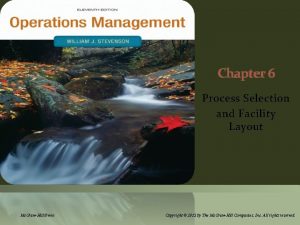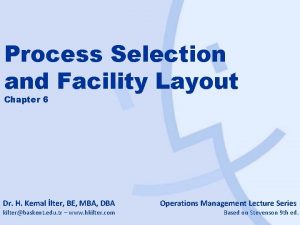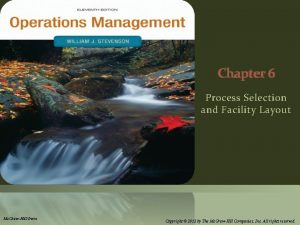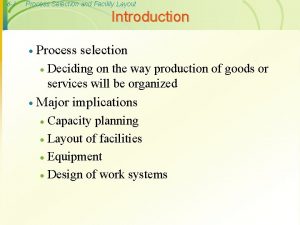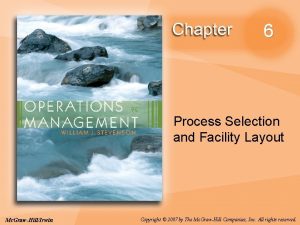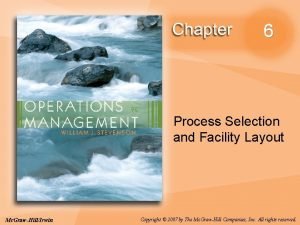Chapter 6 Process Selection and Facility Layout Copyright











































![Example: Armstrong Pumps Line Balancing – Minimum Number of Workstations = [(42. 8)(10)]/45 = Example: Armstrong Pumps Line Balancing – Minimum Number of Workstations = [(42. 8)(10)]/45 =](https://slidetodoc.com/presentation_image/096d5b491cac458bd090c9fe8e51ca2e/image-44.jpg)







- Slides: 51

Chapter 6 Process Selection and Facility Layout Copyright © 2015 Mc. Graw-Hill Education. All rights reserved. No reproduction or distribution without the prior written consent of Mc. Graw-Hill Education.

Chapter 6: Learning Objectives You should be able to: LO 6. 1 LO 6. 2 LO 6. 3 LO 6. 4 LO 6. 5 LO 6. 6 LO 6. 7 LO 6. 8 LO 6. 9 Explain the strategic importance of process selection and the influence it has on the organization and its supply chain Name the two main factors that influence process selection Compare the four basic processing types Explain the need for management of technology List some reasons for redesign of layouts Describe product layouts and their main advantages and disadvantages Describe process layouts and their main advantages and disadvantages Solve simple line-balancing problems Develop simple process layouts 6 -2

Process Selection Process selection Refers to deciding on the way production of goods or services will be organized It has major implications for Capacity planning Layout of facilities Equipment Design of work systems LO 6. 1 6 -3

Process Selection and System Design LO 6. 1 6 -4

Process Strategy Key Aspects of Process Strategy: Capital Intensity The mix of equipment and labor that will be used by the organization Process flexibility The degree to which the system can be adjusted to changes in processing requirements due to such factors as Product and service design changes Volume changes Changes in technology LO 6. 1 6 -5

Process Selection Two key questions in process selection: 1. How much variety will the process need to be able to handle? 2. How much volume will the process need to be able to handle? Job Shop Batch Repetitive LO 6. 2 Continuous 6 -6

Types of Processing Repetitive/ Assembly Job Shop Batch Description Customized goods or services Semistandardized goods or services Standardized goods or services Highly standardized Goods or services Advantages Able to handle a wide variety of work Flexibility; easy to add or change products or services Low unit cost, high volume, efficient Very efficient, very high volume Disadvantages Slow, high cost per unit, complex planning and scheduling Moderate cost per unit, moderate scheduling complexity Low flexibility, high cost of downtime Very rigid, lack of variety, costly to change, very high cost of downtime LO 6. 3 Continuous 6 -7

Sustainable Production of Goods and Services There is increasing pressure for organizations to operate sustainable production processes According to the Lowell Center for Sustainable Production: “Sustainable Production is the creation of goods and services using processes and systems that are: nonpolluting; conserving of energy and natural resources; economically efficient; safe and healthful for workers, communities, and consumers; and, socially and creatively rewarding for all working people. ” 6 -8

Process and Information Technology Process and Information technology can have a major impact on costs, productivity and competitiveness: Process technology Methods, procedures, and equipment used to produce goods and provide services Information technology The science and use of computers and other electronic equipment to store, process, and send information 6 -9

The Need to Manage Technology Process technology and information technology can have a profound impact on: Costs Productivity Competitiveness LO 6. 4 6 -10

Automation Machinery that has sensing and control devices that enable it to operate automatically Fixed automation Programmable automation Flexible automation 6 -11

Programmable Automation Involves the use of high-cost, general-purpose equipment controlled by a computer program that provides both the sequence of operations and specific details about each operation Computer-Aided Manufacturing (CAM) The use of computers in process control, ranging from robots to automated quality control Numerically Controlled (N/C) Machines that perform operations by following mathematical processing instructions Robot A machine consisting of a mechanical arm, a power supply, and a controller 6 -12

Flexible Automation Flexible automation evolved from programmable automation. It uses equipment that is more customized than that of programmable automation. A key difference between the two is that flexible automation requires significantly less changeover time. FMS (Flexible Manufacturing System) A group of machines designed to handle intermittent processing requirements and produce a variety of similar products CIM (Computer Integrated Manufacturing) A system for linking a broad range of manufacturing activities through an integrated computer system 6 -13

Flexible Manufacturing System (FMS) FMS A group of machines designed to handle intermittent processing requirements and produce a variety of similar products Have some of the benefits of automation and some of the flexibility of individual, or stand-alone, machines Includes supervisory computer control, automatic material handling, and robots or other automated processing equipment 6 -14

Computer Integrated Manufacturing (CIM) CIM A system for linking a broad range of manufacturing activities through an integrated computer system Activities include Engineering design FMS Purchasing Order processing Production planning and control The overall goal of CIM is to link various parts of an organization to achieve rapid response to customer orders and/or product changes, to allow rapid production and to reduce indirect labor costs 6 -15

Facilities Layout the configuration of departments, work centers, and equipment, with particular emphasis on movement of work (customers or materials) through the system Facilities layout decisions arise when: Designing new facilities Re-designing existing facilities 6 -16

The Need for Layout Planning 1. Inefficient operations High cost Bottlenecks 2. 3. 4. 5. 6. 7. 8. Accidents or safety hazards Changes in product or service design Introduction of new products or services Changes in output volume or product mix Changes in methods or equipment Changes in environmental or other legal requirements Morale problems LO 6. 5 6 -17

Layout Design Objectives Basic Objective Facilitate a smooth flow of work, material, and information through the system Supporting objectives 1. Facilitate product or service quality 2. Use workers and space efficiently 3. Avoid bottlenecks 4. Minimize material handling costs 5. Eliminate unnecessary movement of workers or material 6. Minimize production time or customer service time 7. Design for safety LO 6. 5 6 -18

Basic Layout Types Product layouts Process layouts Fixed-Position layout Combination layouts 6 -19

Repetitive Processing: Product Layouts Product layout Layout that uses standardized processing operations to achieve smooth, rapid, high-volume flow Raw materials or customer Material and/or labor Station 1 Material and/or labor Station 2 Material and/or labor Station 3 Station 4 Finished item Material and/or labor Used for Repetitive Processing Repetitive or Continuous LO 6. 6 6 -20

Product Layouts: Advantages & Disadvantages Advantages Disadvantages High rate of output Creates dull, repetitive jobs Low unit cost Poorly skilled workers may not Labor specialization Low material handling cost per unit High utilization of labor and equipment Established routing and scheduling Routine accounting, purchasing, and inventory control maintain equipment or quality of output Fairly inflexible to changes in volume or product or process design Highly susceptible to shutdowns Preventive maintenance, capacity for quick repair and spare-parts inventories are necessary expenses Individual incentive plans are impractical LO 6. 6 6 -21

Non-repetitive Processing: Process Layouts Process layouts Layouts that can handle varied processing requirements LO 6. 7 Dept. A Dept. C Dept. E Dept. B Dept. D Dept. F Used for Intermittent processing Job Shop or Batch 6 -22

Process Layouts: Advantages & Disadvantages Advantages Disadvantages Can handle a variety of processing In-process inventories can be high requirements Not particularly vulnerable to equipment failures General-purpose equipment is often less costly and easier and less costly to maintain It is possible to use individual incentive systems Routing and scheduling pose continual challenges Equipment utilization rates are low Material handling is slow and inefficient Reduced spans of supervision Special attention necessary for each product or customer Accounting, inventory control, and purchasing are more involved LO 6. 7 6 -23

Fixed Position Layouts Fixed Position layout Layout in which the product or project remains stationary, and workers, materials, and equipment are moved as needed 6 -24

Combination Layouts Some operational environments use a combination of the three basic layout types: Hospitals Supermarket Shipyards Some organizations are moving away from process layouts in an effort to capture the benefits of product layouts Cellular manufacturing Flexible manufacturing systems 6 -25

Service Layout Service layouts can be categorized as: product, process, or fixed position Service layout requirements are somewhat different due to such factors as: Degree of customer contact Degree of customization Common service layouts: Warehouse and storage layouts Retail layouts Office layouts 6 -26

Cellular Layouts Cellular production Layout in which workstations are grouped into a cell that can process items that have similar processing requirements Groupings are determined by the operations needed to perform the work for a set of similar items, part families, that require similar processing The cells become, in effect, miniature versions of product layouts 6 -27

Group Technology Group technology The grouping into part families of items with similar design or manufacturing characteristics Design Characteristics: Size Shape Function Manufacturing or processing characteristics Type of operations required Sequence of operations required Requires a systematic analysis of parts to identify the part families 6 -28

Service Layouts Two key factors: Customer contact Degree of customization Layouts: Warehouse and storage layouts Retail layouts Office layouts 6 -29

Designing Product Layouts: Line Balancing The goal of a product layout is to arrange workers or machines in the sequence that operations need to be performed LO 6. 8 6 -30

Line Balancing Line balancing The process of assigning tasks to workstations in such a way that the workstations have approximately equal time requirements Goal: Obtain task grouping that represent approximately equal time requirements since this minimizes idle time along the line and results in a high utilization of equipment and labor Why is line balancing important? 1. It allows us to use labor and equipment more efficiently. 2. To avoid fairness issues that arise when one workstation must work harder than another. LO 6. 8 6 -31

Cycle Time Cycle time The maximum time allowed at each workstation to complete its set of tasks on a unit Cycle time also establishes the output rate of a line LO 6. 8 6 -32

How Many Workstations are Needed? The required number of workstations is a function of Desired output rate Our ability to combine tasks into a workstation Theoretical minimum number of stations LO 6. 8 6 -33

Precedence Diagram Precedence diagram A diagram that shows elemental tasks and their precedence requirements LO 6. 8 6 -34

Assigning Tasks to Workstations Common Heuristic (Intuitive) Rules: Assign tasks in order of most following tasks Count the number of tasks that follow Assign tasks in order of greatest positional weight. Positional weight is the sum of each task’s time and the times of all following tasks. LO 6. 8 6 -35

Measuring Effectiveness Balance delay (percentage of idle time) Percentage of idle time of a line Efficiency Percentage of busy time of a line LO 6. 8 6 -36

Planning Product Layouts Line Balancing Procedure 1. Determine the tasks involved in completing 1 unit 2. Determine the order in which tasks must be done 3. Draw a precedence diagram 4. Estimate task times 5. Calculate the cycle time 6. Calculate the minimum number of workstations 7. Use a heuristic to assign tasks to workstations 6 -37

Planning Product Layouts Line Balancing Heuristics Heuristic methods, based on simple rules, have been developed to provide good (not optimal) solutions to line balancing problems Heuristic methods include: Incremental utilization (IU) method See example below in next PP slides The most number of following tasks See Example 1 on p. 264 The greatest positional weight See Example 2 on p. 267 6 -38

Planning Product Layouts Incremental Utilization Method Add tasks to a workstation in order of task precedence one at a time until utilization is 100% or is observed to fall Then the above procedure is repeated at the next workstation for the remaining tasks Pro – Appropriate when one or more task times is equal to or greater than the cycle time Con – Might create the need for extra equipment 6 -39

Example: Armstrong Pumps Line Balancing Armstrong produces bicycle tire pumps on a production line. The time to perform the 6 tasks in producing a pump and their immediate predecessor tasks are shown on the next slide. Ten (10) pumps per hour must be produced and 45 minutes per hour are productive. Use the incremental utilization heuristic to combine the tasks into workstations in order to minimize idle time. 6 -40

Example: Armstrong Pumps Line Balancing Task A B C D E F Tasks that Immediately Precede -A -B, C D E Time to Perform Task (min. ) 5. 4 3. 2 1. 5 2. 8 17. 1 12. 8 Total = 42. 8 6 -41

Example: Armstrong Pumps Line Balancing – Network (Precedence) Diagram A B D E F C 6 -42

Example: Armstrong Pumps Line Balancing – Cycle Time = 45/10 = 4. 5 minutes per pump 6 -43
![Example Armstrong Pumps Line Balancing Minimum Number of Workstations 42 81045 Example: Armstrong Pumps Line Balancing – Minimum Number of Workstations = [(42. 8)(10)]/45 =](https://slidetodoc.com/presentation_image/096d5b491cac458bd090c9fe8e51ca2e/image-44.jpg)
Example: Armstrong Pumps Line Balancing – Minimum Number of Workstations = [(42. 8)(10)]/45 = 9. 51 workstations 6 -44

Example: Armstrong Pumps Line Balancing – Incremental Utilization Heuristic WS Tasks Mins. /pump #WS’s Incr. Util. 1 A 5. 4/4. 5=1. 2= 2 60. 0% 1 A, B 5. 4 + 3. 2 8. 6/4. 5=1. 9= 2 95. 0% 1 A, B, C 8. 6 + 1. 5 10. 1/4. 5=2. 2= 3 49. 8% 2 C 1. 5/4. 5=. 33= 1 33. 3% 2 C, D 1. 5 + 2. 8 4. 3/4. 5=. 96= 1 95. 6% 2 C, D, E 4. 3 + 17. 1 21. 4/4. 5=4. 8= 5 95. 1% 3 E 17. 1/4. 5=3. 8= 4 95. 0% 3 E, F 17. 1 + 12. 8 29. 9/4. 5=6. 6= 7 94. 9% 4 F 12. 8/4. 5=2. 8= 3 94. 8% 6 -45

Example: Armstrong Pumps Line Balancing – Utilization of Production Line = 9. 51/10 =. 951 = 95. 1% 6 -46

Planning Product Layouts Rebalancing a Production Line Changes that can lead to production lines being out of balance or having insufficient/excess capacity are: Changes in demand Machine modifications Variations in employee learning and training 6 -47

Designing Process Layouts The main issue in designing process layouts concerns the relative placement of the departments Measuring effectiveness A major objective in designing process layouts is to minimize transportation cost, distance, or time LO 6. 9 6 -48

Information Requirements In designing process layouts, the following information is required: 1. 2. 3. 4. 5. 6. LO 6. 9 A list of departments to be arranged and their dimensions A projection of future work flows between the pairs of work centers The distance between locations and the cost per unit of distance to move loads between them The amount of money to be invested in the layout A list of any special considerations The location of key utilities, access and exit points, etc. 6 -49

Process Layout Problem Distance between locations in meters To From A A B C 20 40 B 30 C Interdepartmental work flows (loads per day) To From 1 LO 6. 9 1 2 3 30 170 100 6 -50

Process Layout Problem 30 1 170 A 100 2 B C Dept. Loads Location Distance (meters) Load Distance Score 1 to 2 170 A to B 20 170 x 20 = 3, 400 1 to 3 30 A to C 40 30 x 40 = 1, 200 2 to 3 100 B to C 30 100 x 30 = 3, 000 Total LO 6. 9 3 7, 600 6 -51
 Process selection and facility layout pdf
Process selection and facility layout pdf Chapter 6 process selection and facility layout
Chapter 6 process selection and facility layout Importance of process selection and facility layout
Importance of process selection and facility layout Importance of process selection and facility layout
Importance of process selection and facility layout Importance of process selection and facility layout
Importance of process selection and facility layout Process selection and facility layout
Process selection and facility layout Perencanaan lokasi perusahaan
Perencanaan lokasi perusahaan Objective of plant layout
Objective of plant layout Facility layout objectives
Facility layout objectives Type of facility layout
Type of facility layout Meaning of facility layout
Meaning of facility layout Craft layout example
Craft layout example Objectives of facility layout
Objectives of facility layout Aldep algorithm example
Aldep algorithm example Facility layout objectives
Facility layout objectives Satisfactory layout
Satisfactory layout Two way selection and multiway selection
Two way selection and multiway selection Multiway selection
Multiway selection Mass selection and pure line selection
Mass selection and pure line selection Facility management process flow chart
Facility management process flow chart Chapter 8 the international market selection process
Chapter 8 the international market selection process Balancing selection vs stabilizing selection
Balancing selection vs stabilizing selection Artificial selection vs natural selection
Artificial selection vs natural selection K selection r selection
K selection r selection Natural selection vs artificial selection
Natural selection vs artificial selection Difference between continuous and discontinuous variation
Difference between continuous and discontinuous variation What is artificial selection
What is artificial selection What is exponential growth in ecology
What is exponential growth in ecology Natural selection vs artificial selection
Natural selection vs artificial selection Numerator layout vs denominator layout
Numerator layout vs denominator layout Smil head layout root-layout
Smil head layout root-layout Cddat
Cddat Fixed vs fluid layout
Fixed vs fluid layout Facilities planning definition
Facilities planning definition Recruitment selection and placement process
Recruitment selection and placement process Process selection and capacity planning
Process selection and capacity planning Degree of vertical integration
Degree of vertical integration Process selection operations management
Process selection operations management Process selection in operations management
Process selection in operations management Process selection in operations management
Process selection in operations management Methods of recruitment and selection of salesperson
Methods of recruitment and selection of salesperson Recruitment selection and induction policies and procedures
Recruitment selection and induction policies and procedures Process selection and capacity planning
Process selection and capacity planning Identifying and selecting systems development projects
Identifying and selecting systems development projects Resourcing strategy
Resourcing strategy Product design process in operations management
Product design process in operations management Selection of welding process
Selection of welding process Recruitment & selection process
Recruitment & selection process Contoh sequence process
Contoh sequence process Recruitment policy meaning
Recruitment policy meaning Objective selection
Objective selection Service design process
Service design process
